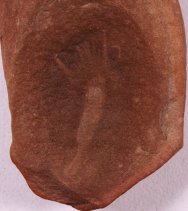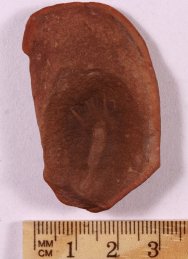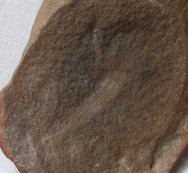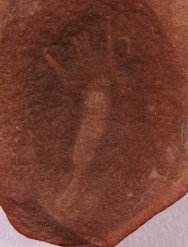Flaberigellidae
Phylum Annelida,
Class Polychaeta, Family Flaberigellidae
Geological
Time: Pennsylvanian (~300 m.y.a.)
Size (25.4
mm = 1 inch): Fossil is 25 mm long on a 50 mm by 30 mm nodule
Fossil Site:
Mazon Creek, Pit 11, Francis Creek shale, Braidwood, Illinois
Code: AW69
Price: Sold
 Description:
The Mazon Creek deposits of the region near Braidwood, Illinois
rival the other famous Lagerstatten of the Burgess Shale, Solnhofen,
and Liaoning for the variety of detailed life preserved. Many
exquisitely-preserved specimens are found in the ironstone nodules
that make up the deposits. The majority of collecting areas are
the spoil heaps of abandoned coal mines, the most famous of which
is Peabody Coal Pit 11. Pit 11 now serves as a cooling pond for
the Braidwood nuclear power plant, but with over 100 other localities,
specimens still come to light. The Polychaeta (Bristleworms)
have a diverse representation among Mazon Creek specimens. The
segmented bodies of the Polychaeta have paired lobes called parapodia
which have a function in locomotion or respiration. The parapodia
bear numerous bristles which are the source of the name of the
class (Polychaeta means many bristles). This one is what is known
as a Bristlecage Worm, a term derived from the long setae surrounding
the head. The worm used these to filter diatoms, radiolarian,
and foraminifers from the water. Description:
The Mazon Creek deposits of the region near Braidwood, Illinois
rival the other famous Lagerstatten of the Burgess Shale, Solnhofen,
and Liaoning for the variety of detailed life preserved. Many
exquisitely-preserved specimens are found in the ironstone nodules
that make up the deposits. The majority of collecting areas are
the spoil heaps of abandoned coal mines, the most famous of which
is Peabody Coal Pit 11. Pit 11 now serves as a cooling pond for
the Braidwood nuclear power plant, but with over 100 other localities,
specimens still come to light. The Polychaeta (Bristleworms)
have a diverse representation among Mazon Creek specimens. The
segmented bodies of the Polychaeta have paired lobes called parapodia
which have a function in locomotion or respiration. The parapodia
bear numerous bristles which are the source of the name of the
class (Polychaeta means many bristles). This one is what is known
as a Bristlecage Worm, a term derived from the long setae surrounding
the head. The worm used these to filter diatoms, radiolarian,
and foraminifers from the water.
|
|



